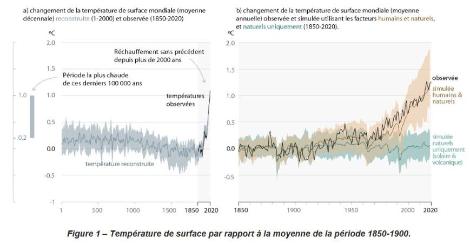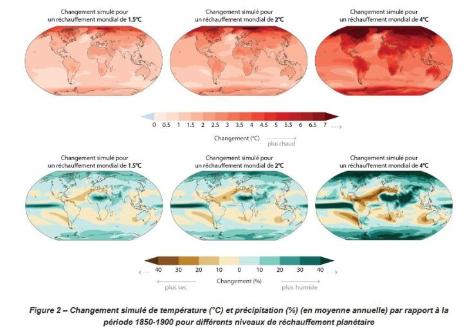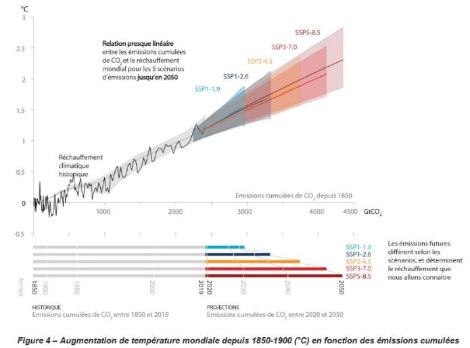Summary of the IPCC AR6 report
Working Group I
août 2021
The IPCC (Intergovernmental Panel on Climate Change) is an organisation of 195 UN member states whose objective is to regularly assess the state of the art of scientific knowledge on climate without bias. It brings together thousands of volunteer experts from around the world to assess, analyse and synthesise the many scientific studies on the subject. IPCC reports are at the heart of international climate negotiations, such as the Paris Agreement (COP21) in 2015 and COP26 in Glasgow in November. In 2007, the IPCC shared the Nobel Peace Prize with Al Gore. The IPCC is organised into three working groups. Group 1 studies the scientific aspects of climate change and produced this report. Group 2 assesses the impacts, vulnerability and adaptation to climate change, and Group 3 studies its mitigation; they will publish their report in 2022.
À télécharger : ipcc_ar6_wgi_spm.pdf (3,2 Mio)
The current state of the climate
The influence of humans on the warming of the atmosphere, oceans and continents is unequivocal. By emitting greenhouse gases (GHGs), humanity has caused rapid and widespread changes in the atmosphere, cryosphere (land and sea ice), biosphere (living things) and oceans.

The main GHGs emitted by humans are carbon dioxide (CO2), methane (CH4), and nitrous oxide (N2O). Part of the human emissions are captured by the ocean and at the surface of the continents (56% for CO2). The rest is stored in the atmosphere, increasing its concentration. This concentration is expressed in parts per million (ppm) or parts per billion (ppb). These ppm and ppb are the equivalent of percentages, but related to 1 million (ppm) or 1 billion (ppb). For example, 1 ppm is 1 in 1 million. From 1750 to 2019, atmospheric concentrations have increased from about 280 to 410 ppm for CO2, from about 800 to 1866 ppb for CH4, and from about 270 to 332 ppb for N2O. Although the atmospheric concentration of CH4 is about 220 times lower than that of CO2, CH4 is responsible for more than a quarter of the warming due to its greater warming power. The magnitude of these variations for CO2 and CH4 far exceeds the natural variations between ice ages and interglacial periods over the past 800,000 years. The current CO2 concentration is the highest in at least 2 million years.
This increase in GHG concentration has led to a significant accumulation of energy in the form of heat at the Earth’s surface. Of this energy, 91% is found in the oceans, 5% on continental surfaces, 3% in the ice (causing it to melt), and only 1% in the atmosphere.
However, this tiny proportion (1%) of heat trapped in the atmosphere is the main cause of the warming observed since 1850: the global surface temperature over the period 2011-2020 was 1.09°C warmer than that over the period 1850-1900, with a greater warming over the continents (+1.59°C) than over the oceans (+0.88°C) Global surface temperature warming directly attributable to humans is estimated at 1.07°C, accounting for almost all of the observed warming. Warming has also accelerated, with +0.19°C between the period 2003-2012 and the period 2011-2020. The rate of warming over the past 50 years is unprecedented for at least 2000 years. Current temperatures exceed the maximum of the last warm period 6500 years ago, and are likely to exceed the previous maximum of 125 000 years ago (FIGURE 1).
The accumulation of heat in the ice, in turn, has led to a retreat of the glaciers and the Arctic ice pack. Between the periods 1979-1988 and 2010-2019, the Arctic sea ice area has decreased by 40% in late summer, its lowest value since at least 1850. The near-simultaneous retreat of most of the world’s glaciers is also unprecedented in at least the last 1000 years. Similarly, human influence on climate is most likely responsible for the melting of the Greenland ice sheet over the last two decades, which was 4 times faster over the decade 2010-2019 than over the period 1992-1999. In contrast, no trend is confirmed for the Antarctic ice cap since 1979.
The melting of continental ice (mountain glaciers, Greenland ice cap) is also responsible for 42% of the sea level rise over the period 1971-2018. In addition, there is the thermal expansion effect: the volume of a given body of water increases when its temperature rises. This effect is responsible for half of the rise in sea level.
Sea level rose by 20 cm between 1901 and 2018. From a rate of 1.3 mm/year between 1901 and 1971, the rise accelerated to +3.7 mm/year in the period 2006-2018. As a result, the sea level has risen faster since 1900 than in any century in the last 3000 years. Over the same period, the ocean has also warmed faster than it has since the end of the last deglaciation, about 11,000 years ago. In addition to affecting temperature and sea level, the dissolution of some of the man-made CO2 into surface waters is increasing the acidity of the oceans. Over the last few decades, this has reached a level that is unusual for the last 2 million years, which represents a major risk for marine biodiversity by causing the decline of many ecosystems.
By disrupting the climate, humanity has also caused changes in the frequency of extreme weather and climate events, which have become more frequent and intense overall since 1950. This is the case for extreme heat, the frequency of which has doubled since the 1980s, heavy precipitation (particularly in northern Europe), forest fires, floods and hurricanes. In addition, soil droughts are occurring in some regions, particularly around the Mediterranean basin, in southern and western Africa, and in western North America.
Possible future climates
As a result of past and future GHG emissions, the changes in the climate system observed in recent decades will continue throughout the 21st century and beyond. This will increase the likelihood of severe, widespread and irreversible impacts on ecosystems and humans.
Temperatures will continue to rise globally - on average 1.4 to 1.7 times more on land than at sea, and at least twice as much at the North Pole as elsewhere (FIGURE 2). Sea level rise and ocean acidification will continue. Heat waves, extreme rainfall and severe hurricanes will become more frequent and intense, while cold snaps will become less frequent. Extreme events of unprecedented magnitude are certain to occur. Land ice and permafrost will continue to melt and Arctic sea ice will retreat, particularly in summer. An almost ice-free summer in the Arctic is likely before 2050, whatever we do.
Climate change will lead to an intensification of the hydrological cycle (FIGURE 2). Precipitation will be more abundant overall, especially in high latitudes, the tropics and most monsoon regions, but more variable within seasons and from year to year. Some areas will receive less rain in the future, however, such as the Mediterranean and several subtropical regions. On average, rainfall events - particularly those associated with monsoons - as well as droughts will be more intense, although again significant regional variations are expected. The IPCC has also made available an interactive atlas to visualise the expected regional climate changes for different global warming values.

The significance of these changes depends mainly on future GHG emissions. To study possible future impacts, the IPCC therefore used five scenarios called SSPs (Shared Socio-economic Pathways). These scenarios reflect various possible future developments in terms of population, economic and technological development and environmental policies (FIGURE 3). They range from fairly optimistic scenarios based on large immediate reductions in GHG emissions (SSP1-1.9 and SSP1-2.6), through ‘intermediate’ scenarios (SSP2- 4.5, SSP3-7.0) to a ‘worst-case’ scenario in which annual GHG emissions would triple by 2100 (SSP5-8.5). These scenarios are then used to run global climate models: algorithms that simulate global climate change over decades. The climate models used for this 6th IPCC report show considerable improvements over the previous generation.

With CO2 remaining in the atmosphere for an average of a century, global temperatures will continue to rise until at least 2050, no matter what we do over the next few decades. Even with immediate reductions in GHG emissions, the +1.5°C mark will be reached, and has a 50/50 chance of being exceeded by 2040 - less than 20 years from now! Note that these figures represent 20-year averages - so it is likely that +1.5°C will be reached at some point well before 2040, perhaps even by 2025. A rapid reduction in emissions would nevertheless make it possible to significantly limit global warming by 2100, to between 1.4 and 1.8°C, while it would reach 2.7 to 3.6°C in the intermediate scenarios and 4.4°C in the worst case scenario. The +2°C barrier would thus be largely crossed before 2060, except in the optimistic scenarios.
Although it may seem insignificant, a difference of 0.5°C in global warming has major consequences, especially for extreme events. A heat peak that occurred once every 50 years a century ago is already five times more frequent today, while the global temperature has increased by ‘only’ 1°C. With 1.5°C warming, it would be almost 9 times more frequent, and almost 14 times more frequent at +2°C, while at +4°C it would occur almost every year. Any increase in warming also reduces the effectiveness of natural carbon sinks (oceans, soils, vegetation).
Even if we manage to limit the temperature increase to 1.5°C by 2100, three major changes are irreversible on a human lifetime scale: warming and acidification of the oceans, melting of glaciers and polar ice caps, and sea level rise. Future reductions in GHG emissions will only slow down but not stop these phenomena, even if surface temperatures no longer rise. This is because the inertia of the oceans and land ice is much greater than that of the atmosphere. So whatever we do, past warming will be felt for centuries or even millennia.
By 2050, sea levels are expected to rise by at least 18 cm above the 1995-2014 average, regardless of GHG emissions. By 2100, it is projected to rise by 38 cm in the most optimistic scenarios and by 77 cm for SSP5-8.5. Beyond that, the level will continue to rise as the deep ocean warms and land ice melts - by +0.6-1.4m as early as 2150 and +2-3m over the next 2,000 years, and this for a world that is only 1.5°C warmer. These figures are consistent with what we know about warmer climates in the past.
Even more abrupt increases in the coming decades cannot be excluded. In the worst case, a rise of 2m could be reached as early as 2100, following a partial collapse of the polar ice caps - a highly unlikely event, but not impossible given our very imperfect knowledge of the behaviour of ice caps in a warmer world. A warming of more than +3°C could also cause the Greenland ice to disappear completely within a few thousand years. Other abrupt climate changes (tipping points) are also possible during the 21st century if we fail to stay below +1.5°C, such as the disappearance of the Amazon rainforest under the combined effect of warming and deforestation.
Climate risks and regional adaptations
The greater the global warming, the greater the regional impacts on human societies and ecosystems.
Extreme precipitation and associated flooding will be more frequent and severe in many regions, starting at 1.5°C of warming. The same applies to droughts. At +2°C, average precipitation is projected to increase in many parts of the world, especially in northern Europe.
Urbanisation can increase the impact of precipitation by exacerbating rainfall and local runoff. The severity of heatwaves will also be amplified in cities. For coastal cities, flooding will be more likely due to the dual phenomenon of runoff and marine submersion. The latter phenomenon will be aggravated by the continuing rise in sea level and coastal erosion. The extreme sea heights reached every 100 years in the past could occur every year by 2100 in more than half of the assessed sites.
Although unlikely, events such as the collapse of the Antarctic polar ice cap or the Atlantic ocean circulation, and forest dieback could have serious consequences for humans and ecosystems. These potential tipping points need to be considered in the risk assessment.
The Atlantic Ocean circulation (of which the Gulf Stream is a part) will almost certainly weaken in the 21st century under any scenario. Although a sudden change in this circulation is rather unlikely before 2100, its eventual collapse would cause an abrupt change in global weather patterns and the water cycle: a southward shift in the tropical rainfall zone, weakening of the African and Asian monsoons, increased monsoons in the Southern Hemisphere and drying out in Europe.
All these changes can be amplified or temporarily mitigated by other natural phenomena such as solar cycles or volcanic eruptions. However, it is certain that as GHG emissions increase, the likelihood of these changes occurring increases. Similarly, extreme events of unprecedented intensity will occur in places that have been spared until now.
Limiting climate change
A major finding of this report is that limiting warming to +1.5°C by 2100 - the stated goal of the Paris Agreement - is impossible without major and immediate reductions in GHG emissions, followed by the net removal of atmospheric CO2. In particular, this implies achieving carbon neutrality (emissions must be offset by CO2 capture) soon after 2050. Indeed, there is a quasi-linear relationship between the cumulative amount of GHGs in the atmosphere and global warming. Each additional 1000 Gt (Gigatonne = billion tonnes) of CO2 increases the global average surface temperature by about 0.45°C. Limiting the rise in temperature therefore implies respecting a strict carbon budget.

Between 1850 and 2019, humanity emitted about 2390 Gt of CO2, 64% of which came from fossil fuels (a fraction rising to 86% for the last 10 years). Remaining CO2 budgets have therefore been estimated from 2020 onwards until carbon neutrality is achieved for each scenario. For example, to have a 50/50 chance of limiting warming to +1.5°C, there would be about 500 Gt of CO2 left to emit. At the current rate, this budget would be exceeded in 2032. To stay below +2°C, the budget would be 1350Gt of CO2. It is also notable that despite the reduction in emissions in 2020 (due to COVID-19), the CO2 curve has continued to climb.
Achieving carbon neutrality relies on removing CO2 from the atmosphere, using natural systems (vegetation, soils, etc.) or industrial processes to store it. Deployed on a sufficient scale, these methods could reduce the concentration of GHGs in the atmosphere. This would reduce warming and acidification of the oceans and improve water quality. However, some impacts will last for centuries or even millennia, such as sea level rise.
Reducing GHG emissions will also have a positive effect on air quality. Aerosols (including fine particles) are often emitted when fossil fuels are burned. Although aerosols reflect some of the sun’s radiation back into space and help to cool the atmosphere, this temporary cooling is smaller than the warming caused by GHGs. Reducing aerosols as well as GHGs therefore helps to limit global warming.
The climate that present and future generations will experience will depend on future emissions. Reducing them quickly will limit the changes. On the other hand, continuing on our current path will lead to greater and more rapid upheavals, which will gradually affect all regions of the world, and for which our societies are not prepared. Some changes will last for centuries or millennia: our choices today will have consequences for a very long time.